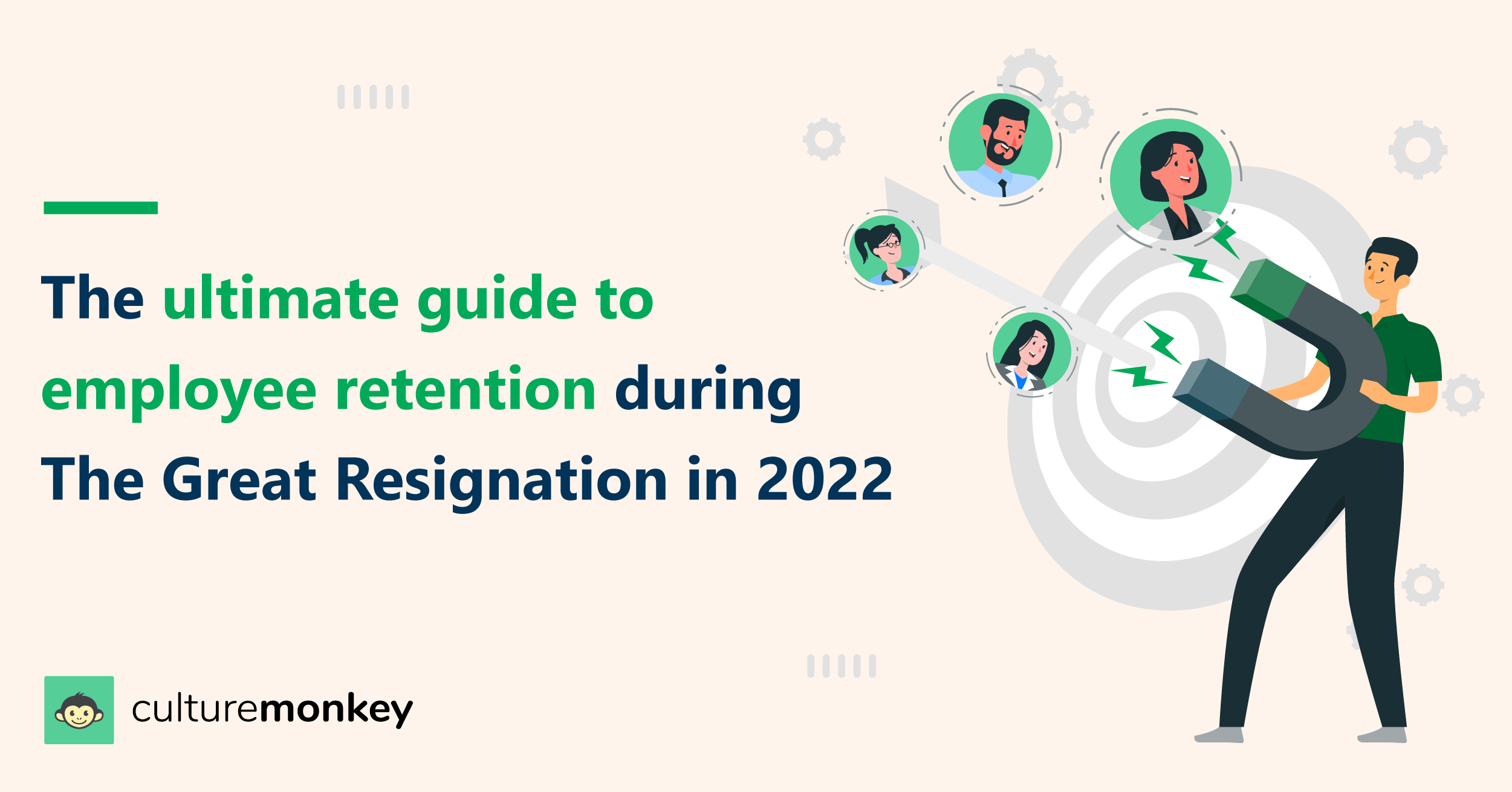The ultimate guide to employee retention during the great resignation in 2022

Table of contents:
- What is great resignation? Why is employee retention becoming a challenge?
1.1 Why is employee retention tough amid the great resignation? - What is the meaning of employee retention?
- Is it great resignation or a great reshuffle?
2.1 Challenges of employee retention for HR leaders
2.2 Best practices for HR leaders to follow to magnify employee retention
2.3 Turning employee attrition into employee retention
2.4 Sow the seeds of great retention to build future leaders - What factors are driving “The Great Resignation” and causing low employee retention rates?
- The way forward: Five strategies to retain employees in the great resignation
- Employee pulse survey questions to measure employee retention risks and the employee experience
- Data-driven approach for employers to improve employee retention
The pandemic has reshaped or let’s say revealed what really matters to employees. The lockdown gave employees across the globe months to re-evaluate and rethink what work means to them and how they want to add value to the world with the work they do. On failing to fulfil employee desires, organizations are bound to face employee retention (employee retention meaning covered in the following section) issues.
The harsh truth: companies are opening their office doors for employees to join back, but millions of workers are choosing their fate as they stand at a crossroad and are leaving their jobs as workplaces are unable to provide their employees with the cultures they expect. Why? For the reason that they do not want to return to work, especially after realizing that the employee engagement level and work-life balance is a cut above in work from home setup. The result? High employee turnover and massive employee retention problems.
In this article, we’ll deeply discuss the phenomenon now known as the “The Great Resignation” and elucidate why it’s happening and what’s the way forward for companies to retain their high-performing employees.
What is the “Great Resignation”? Why is employee retention becoming a challenge?
The Great Resignation is a term originated by Professor Anthony Klotz that validated and suggested that a large number of employees are going to resign their jobs after the pandemic ends and life returns to "normal."

As per the U.S. Bureau of Labor Statistics report, nearly 4.4 million Americans quit their jobs in April 2022.
Managers are now navigating through the domino effects of the pandemic as employees re-analyze their workplaces & cultures and resign from their jobs in high numbers. In a recent in-depth analysis by Ian Cook, we found out the two trends that are driving this shift
- Employee resignation rates are highest among mid-career stages
- Employee resignation rates are highest in the technology and healthcare industries
However, now as we turn towards recovery, we observed that employees who are “not” entirely dependent on paychecks are finally taking the step to resign and move out of their jobs. However, employees with a lack of security and unemployment benefits cannot afford this luxury. For the latter pool of employees, the situation after the pandemic is even more stressful and frustrating as following the concept of employee resignation and living a life with comfort and balance under a positive culture is not a choice for them.
These employee resignation trends and circumstances call for data-driven actions to understand why employees are actually resigning and how to combat situations like “The Great Resignation”.
Why is employee retention tough amid the great resignation?
- Workplace Dissatisfaction: If you want to retain your employees, closely observe and listen to their needs and expectations. Overall workplace dissatisfaction and poor culture is the major cause of high turnover.
- Advancement Opportunities: Employees are always looking forward to opportunities to grow and advance. If your company is unable to invest in L&D, employee retention can be extremely challenging for you then.
- Low Compensation: In today's era, compensation is not the only factor to retain employees. But, it's also one of the major reasons for employees to stay around. Double check on market standards and skills of your employees and compensate them well for higher employee retention.
- Lack of DEI: Modern workforce demands diversity, equity and inclusion in their workplace to have a global mindset and enhance their creativity and innovation levels. Look within teams at a micro level and detect if this is a reason for low employee retention levels.
Now that we know how employee retention has become a challenge amid "The Great Resignation", let’s further understand how the patterns of employment have evolved since the inception of The Great Resignation.
The job sector trend has remodeled into something more nuanced. With the increasing uncertainty and disruption waves, millions of workers quit their jobs in search of new roles that promised to live up to their expectations - providing better workplace cultures, work-life balance, and aligned job roles with employee goals and values. This has not only made leaders struggle with employee retention but also create a dent on organizations financially. But, do we really understand the meaning of employee retention? Let's find out.
What is the meaning of employee retention?
Employee retention is of utmost importance. And understand the meaning of employee retention truly matters!
Employee retention is a term associated with employees that defines their intent to stay on with their current company while not actively looking out for other job prospects. The opposite of employee retention is employee turnover, where they choose to leave the company for multiple reasons.
The true meaning of employee retention cited in Chibowa is: Employee Retention is a voluntary move by an organization to create an environment which engages employees for a long term.
Every company and industry has a different retention rate due to different employee factors. The employee retention score depicts the percentage of employees who actually remained with the organization during a fixed period.
So, is it the great resignation or the great reshuffle?
“Almost 44% of the employees are looking for a new job whereas about 6% plan to open their own businesses as per a recent survey”
Clearly, this isn’t employees resigning and leaving work altogether, it’s something bigger than that. Employees are willing to leave toxic workplaces behind causing higher employee retention issues in search of opportunities at companies with better work cultures and leadership. After the pandemic, employees have realized that there is more to work and life, and they are willing to go above and beyond to attain that fulfillment from work. So, this is a signal for leaders to take. If cultures are not improved, employee retention can go for a toss.

Now if we look at “The Great Reshuffle” from a panoramic view, there isn’t really a downside to it. Employee retention is stronger with companies that give them utmost satisfaction and the leaders who indulge their employees in the roles they love and feel passionate about. The success and employee retention rates for such workplaces are going to be much higher and undoubtedly their workforce will be more engaged with cultures of empathy and trust.
The low employee retention we are witnessing now is bigger than anything we've seen before. It’s an extraordinary moment in the history of work where almost every employee is reconsidering not just how they work, but why they work.
Challenges of employee retention for HR leaders:
Now that everyone is mastering how to build planes to fly higher, HR leaders have to transcend, evolve and fly with their employees to attain organizational success and keep the employee retention numbers soaring high . Those who are willing to go for it will ace, but, other may collapse.
The pandemic followed by the great resignation brought remote work into play which made employees understand that work can be done from anywhere and that their physical location doesn’t matter anymore. The need to live in big cities to get big jobs no longer exists. Organizations failing to look at it and provide remote hybrid set ups are witnessing higher employee retention problems. Whereas, for HR leaders, governing employee growth will become complicated as the organizational culture will evolve to be heterogeneous.
Best practices for HR leaders to follow to magnify employee retention:
1. With lower employee retention rates and employees looking for external reshuffling, create development and learning programs and workshops in consultation with what employees seek and how they want to develop to retain and attract employees. Help employees upskill and invest in their growth plans by offering courses or training sessions. Create custom videos in podcast formats that can be used by employees to learn at their own speed.
2. HR leaders must deploy the right technology to manage talent optimally for higher employee retention. Adopting tech-enabled tools to engage with employees is the need of the hour. Build human connections and constantly assess the pulse of the company through gauging on employee sentiment with timely employee engagement surveys. When your employees feel cared for, the willingness to stay will increase impacting the employee retention numbers.
3. HR leaders must ensure that although these initiatives and plans can be drafted and driven centrally, their implementation needs to be decentralized and managers need to take ownership. Once managers come on the front foot and access teams at micro levels, they'll be able to create better cultures based on employee needs which will undoubtedly affect employee retention.
4. Listening to employees is imperative in today’s workplace structures. In smaller organizations, HR leaders must continually host 1-1 sessions and conduct timely anonymous surveys to listen to employees while assuring them that actions will be taken and their concerns will be addressed. For larger organizations, regular pulse surveys should be conducted to gauge employee sentiments throughout the employee lifecycle. Starting from hiring to separation. On acing this, leaders will be able to complete full circles without having employee retention issues, mid journey.
Turning employee attrition into employee retention
Can this be your chance to turn employee attrition into employee retention?
Unquestionably organizations that are willing to dig deeper and take the time to learn the root cause of employee attrition and act tactfully—will have an edge in attracting and retaining employees.

Many companies are struggling to fix their internal employee retention issues so far.
Why? The leadership body is not taking out enough time to investigate the causes of low employee retention, rather they are jumping onto solutions and are making haste choices that hold good intentions, but, are not well informed. For example, to retain employees who are high-performing, they are directly working on their financial perks or are giving unplanned bonuses. In cases where organizations are taking due steps to curb employee retention problems like conducting surveys to understand the causes, the problem arises at a later stage when timely actions are not taken which makes the data stale by the time it's actually put to use. This lag in feedback collection and data analysis again results in higher employee retention problems.
These tricks to employee retention are not permanent solutions but merely band-aid fixes.
The result? It is clearly evident that employees are able to sense the emotion behind these changes. Instead of feeling appreciated, they feel like a transaction for the company and discern that the leadership does not care about their real needs and expectations making very little improvement in employee retention rates. And, companies failing to utilize real-time analytics and take swift action on employee feedback disappoint employees even further.
Just like the employee mindset is working in a similar way, the employer's mind is also the same. Almost every employer is handling the employee retention challenge similarly. But, it’s high time leaders cognize the importance of employee experience to turn “the great attrition” into “the great retention”. Investing in tech-enabled employee engagement tools to meet the new demands of employees, listening to employee sentiments, and taking feedback continually are the meaningful actions leaders can take to retain employees.
“There are high chances that satisfied employees may also be tempted to quit as their options expand”
Sow the seeds of great retention to build future leaders:
To solidify the employee-employer relationship, as the power shifts in employees' hands, leaders and executives should consciously make an effort to listen to their employees and make it a base to all their employee retention strategies.

To kick it up a notch, leaders must introspect deeper and ask the following questions:
- Are we building strong and efficient leaders?
The leadership body in your company must motivate and inspire their employees at all levels and lead with empathy to retain their top-performing employees. - Do we have a strong company culture that aligns with employee values?
A company that values and appreciates its employees will build a culture that offers them work-life balance & flexibility and will empower them to grow and make decisions balancing their personal and professional needs. When your employees feel valued, the need to take extra steps for employee retention will go away. - Is our work environment built for transactional motives solely?
If your organization genuinely cares for its employees, your immediate response to low employee retention would be taking that extra step to listen to your employees and take rapid actions to create an environment that they desire, not simply raising compensation. If your ecosystems are not run by transactional motives, you would want to solve the problems for the long run and for the person (not just their bank accounts). - Are we doing enough for employee career paths and development opportunities?
Employees are always on the lookout to grow themselves. And jobs with better, stronger career opportunities gain more traction. It’s a fact that employees are inclined both towards recognition and development. If you have systems in check where you reward employees not only monetarily but also add new roles and levels to their existing work, then you are on the right track and employee retention will never be an obstacle for an organization like yours.
To hold on to this unique opportunity, take a step back, listen, learn, and make the changes employees want if you really wish to retain them.
What factors are driving “The Great Resignation” and causing low employee retention rates?
“A Microsoft report found that 52% of Gen Z and Millennials are likely to consider changing employers this year, up by 3% year-over-year”

It begs the question: What are the main factors that are encouraging employees to resign and adding to the low employee retention rates each month? Here are the top five drivers of the great resignation:
1. Stress, toxicity, and exhaustion in the current role and low hope for future development:
Lack of career growth opportunities and job dissatisfaction are the two primary reasons employers are unable to retain their employees. These factors got intensified with the onset of the pandemic as employees assessed their work and saw an unalignment with their purpose in life. And worst of employee retention showed face when many companies started pay cuts, reduced bonuses, took back employee benefits, and didn't hesitate to lay off employees due to the fluctuations in their businesses.
DID YOU KNOW? “According to a CNBC report, 26% of employees are planning to leave their employers out of which 80% stated career advancement being a major concern.”
As a result, employees felt like their efforts and sincerity had no importance and that they worked so hard for no recognition as their employers failed to empathize with the workforce.
2. Lack of humanity at the workplace:
The pandemic brought a lot of distress, anxiety, and depression with it. While half the world was grieving, the other half was trying to cope with the endless stream of crises. In these tough times, employees expected extra fellowship and humanity from workplaces but instead found themselves stuck in the loop of financial turnover in their organizations.
DID YOU KNOW? “30% of American workers say their job is “just a job to get them by.”
The lack of meaningful human connections made employees feel like machines grinding themselves with no compassion and for no value.
3. The desire for more flexibility:
The influence of the pandemic on how employees work was massive. With the pandemic, remote work was born and employees have certainly been enjoying it. But, the equations have now changed with the world getting back to normal and offices calling back their employees. Employees are undoubtedly showing resistance towards returning back to the office as they have found comfort in working from home, saving commute time, and spending those extra quality hours with their loved ones.
DID YOU KNOW? “A Morning Consult survey reported that 39% of respondents said they'd consider quitting if their managers weren't flexible about working from home”
This points to another level of urgency for greater flexibility and cultural transformations in the workplaces to attract, retain and engage employees. Else, companies will end up losing all their high-performing employees making retention tougher.
4. Disappointed with the lack of healthy work-life boundaries:
The line between personal and professional lives blurred due to work from home, and people started finding time for skill development and hobbies while enjoying out and about with their family and friends. Being at home awakened employees and made them realize that staying in the office for long hours to complete their assignments has caused burnout, stress, and tension leading to work-life imbalance. Perception of work-life balance evolved and will continue further with cultural, generational, and economic changes.
DID YOU KNOW? “A report by Medallia, Inc found that 70% of those who left due to pandemic influence sought better work-life balance.

Employees desire and expect time away from the office while maintaining productivity by having the flexibility of work. They find themselves more accountable and responsible for work when they have the autonomy to choose their own work models. Leaders must walk that extra mile to provide employees with this basic facility to retain their employees.
5. In search of inclusive workplaces with a sense of belonging:
Employees have realized that they deserve to be seen, heard, respected, and valued by the leaders in the workplace where they have spent their lifetime. Employees need collaborative environments, the right to voice, emotional & cultural intelligence, equal pay, and fair promotions to be devoted to an organization. While the hype of DEI has kept leaders occupied in hiring diverse talent, they forgot the main essence of the entire motto which made it difficult for them to retain employees.
DID YOU KNOW? “According to a recent McKinsey study, 51% of employees stated that their reason to quit is the lack of sense of belonging at work”
Their negligence in equally focusing on making employees feel like they matter and have an important place in their organizations has made them quit jobs in search of workplaces that practice DEI&B more sincerely.
The way forward: Five strategies to retain employees in the great resignation
The dynamics of employee resignations and layoffs have changed. Employees now are less frightened than they were decades ago. This is primarily because employees have understood their worth and know opportunities are available in abundance, full-time or contract-based. With work from home becoming a norm, and remote and hybrid work options increasing, employees find it easier to move on as compared to the period before the pandemic and the great resignation.
But this approach has made it challenging for employers to retain their best employees as compared to the past because an increase in monetary incentives alone does not attract employees anymore. Employees' desires are important and employers need to walk that extra mile to retain their employees. Use these five employee retention techniques amidst the great resignation and reduce future attrition:
“People first cultures should be embedded in the organization's DNA”
- Identify the root cause by conducting a pulse survey:
Employee retention plans can be a success if companies work on employee engagement which starts with listening and understanding your employees. If conducted accurately, surveys can help you understand the factors that could be the reason behind low employee retention rates. The results will help leaders draw actionable insights about the areas employees show the most resistance. Although it’s not possible to resolve every pain point quickly, steps like these will be sufficient enough to bring alterations in the deciding parameters of an employee as they choose to leave or stay.

Leaders can also collect and analyze anonymous feedback from employees who left the organization during the pandemic, and are willing to state their pain areas. By pinpointing why employees left, leaders can create a solid plan of action around those parameters and draft a fail-proof strategy to retain employees and control attrition. Culture Monkey’s science-backed Employee Engagement tool makes it easy for employers to assess the red flags with its pre-build survey templates for engagement, DEI, turnover prediction, and more that could help your organizations sustain such blows.
- Develop tailored employee retention programs:
After you have drawn a conclusion from your employee engagement survey, you’ll be able to lay down the root causes of low employee retention at your organization. The most ideal step to employee retention would be to cater to the different needs of each employee by creating highly customized programs aimed at improving their workplace struggles for them. For example, if your survey shows that people of color are resigning at a higher rate, their feedback report might show a lack of inclusion or racism as a red flag. Creating a DEI-focused approach to cater to this problem could curb attrition.
Most importantly, to strengthen your tailored employee retention plans, reinforce high-level data infrastructure to make these data-driven decisions and track their progress. Invest in a user-friendly system to continually conduct surveys, discover pain points and take swift actions. Deploying a steady tool will facilitate your employees’ journey articulating the increase in satisfaction from your employee retention strategy. - Allow flexible work arrangements:
Your employees could possibly be leaving because they feel their voices aren’t being heard, or the leaders don’t value them. You could behold this pattern if your employees prefer quitting their jobs rather than coming back to office workspaces. To draft a stronger employee retention strategy, give employees substantial flexibility keeping the least control in your hands. Authorize flexible work models and assist them in finding the most efficient hours of the day. Encourage them to create their own goals and designate their own work locations and work hours. This will not only enhance employee productivity but also intensify innovation and creativity.
While 74% of professionals expect remote work to become standard, we are certain that hybrid work is the future of work.
As a result, many employees feel it’s rational to expect the flexibility to choose their own working styles as long as results and productivity aren’t compromised and tasks are completed within the designated time frames.
- Position employee development first:
The pandemic changed the perception of employees. They looked forward to roles that facilitated their growth journeys and focused on their skills. To attract employees and foster their growth and development, companies must proactively and transparently create roadmaps for employee evolution. If radically career pivots are possible, managers should essentially encourage and empower employees to make the most out of it as a part of their employee retention strategy.

Merely offering happy hours will not improve employee retention. Employees want to feel cared for and an impactful way to make them feel so is through committing to their development. Invest in their learning programs and serve them with opportunities that aid employees in upskilling. Encourage managers to become coaches and enhance cross-departmental collaborations.
- Prioritize and maintain a healthy company culture:
Company culture is like the spine of a company. It can really make or break any company. There could be “n” number of reasons for employees to join a company. But, good company culture is the plaster that makes employees stay with a company. Moreover, it’s not just the responsibility of an HR leader to hold the company’s culture. It takes two to tango and managers are equally responsible. Managers must create micro-cultures within the teams to lead a great culture organization-wide. Employers can get away with the worst of “the great resignation” if the leaders are delivering good employee experiences holistically. Senior executives must also give a hand and create a culture of generosity & gratitude in teams and acknowledge & recognize employee efforts. If you create a healthy and positive culture, you can never go wrong with your employee retention.
It’s true that employees had little expectations in the past few years, but with Gen Z entering the workforce, companies need to actively prepare plans to maintain a healthy company culture that is diverse, inclusive, flexible, and respectful. Gen Z has a different outlook as compared to millennials or Gen X. And, to sustain phenomena like the great resignation, companies need to take a different route and proactively evaluate and shape company cultures from the employee's viewpoint if they want to retain their high performing employees. It is imperative to collect real-time feedback (not one time) and assess the toxic culture traits that are driving the great resignation through constant surveys. Analyze employee discomfort and actively drive cultural changes to retain your employees.
Employee pulse survey questions to measure employee retention risks and the employee experience
During highly volatile times like “the great resignation”, HR leaders can prepare robust pulse surveys and leverage the employee feedback to gather insights at a faster pace contrary to the usual planned annual engagement surveys to find out red flags and create dynamic employee retention plans.
But what are pulse surveys?
Pulse surveys may sound like a jargon, but it's really not that complicated. It's the new buzzword in the HR sector that has become increasingly popular in the realm of employee feedback. A pulse survey is comparatively shorter, problem focused and more frequent than an annual engagement survey. These surveys act like an ear to employee sentiments and if done regularly and effectively, they can help organization get away with challenges like low employee retention and disengagement at an early stage. Not just that! Pulse surveys being more agile help HR leaders plot trends and measure improvements rapidly in contrast to annual surveys.
Use these survey questions stated below as a sample pulse survey to identify and measure the potential employee retention risks in your company and any problems that might be prevailing with the employee experience.

- On a scale of 1-10, how likely would you refer your friends & family to work here?
- If you were to give a notice letter and leave our company, what would be the primary reason for you to take this decision?
- On a scale of 1-10 how much do agree with this sentence: It would be difficult for me to find another job as good as this one.
- Do you see yourself with this company for the next 2 years?
- Are you provided with enough growth and development opportunities?
- Do you feel that you are paid according to your skill set?
- Do you managers make you feel valued and recognize your work?
- Have you ever been discriminated against, harassed, or bullied at work?
- Does your work align with your personal goals?
- What is the most unpleasant attribute of our company culture?
An employee retention and engagement survey can map out actionable insights and help managers understand how many employees plan to leave the company and what is the major cause for them to leave.
It can help you make data-driven decisions that can reduce employee attrition, prevent layoffs, and retain highly talented employees.
Employers must take a data-driven approach to improve employee retention
The pandemic followed by the great resignation has compelled organizations to work on strengthening employer-employee relationships. To do so, leaders must constructively employ data-driven approaches. Deploying a strong employee engagement tool will help senior executives and managers evaluate the sentiments of those employees who are highly disengaged, unhappy, and on the brink of leaving the organization. With employee challenges popping up on manager dashboards in real-time, leaders can take action before it’s too late.

Leaders can determine how and why people are quitting, and what fragment of the workforce is at the highest turnover risk. Effectively leveraging data and monitoring the employee lifecycle time-to-time will give leaders visibility around the root causes of the pain areas. These insights will ultimately empower managers to attract top talent, improve employee retention, and build a more engaged and effective workforce.
It’s crystal clear that we have been bestowed with an incredible opportunity to re-shape the world of work and it’s crucial for leaders to remember what their employees want and keep them at the heart of everything to truly build a workplace culture that works for them.



